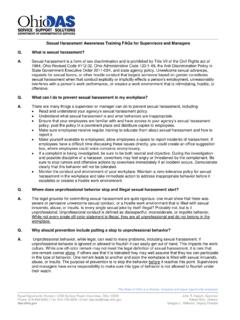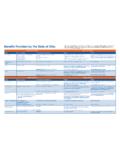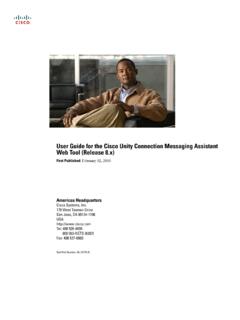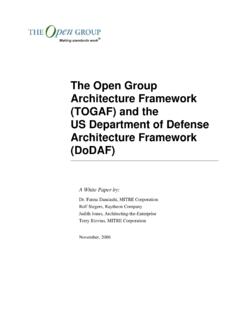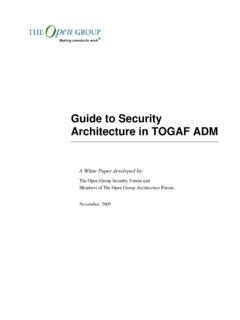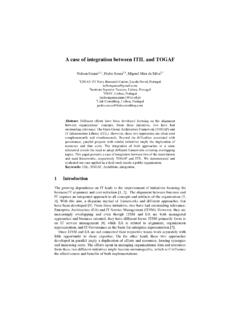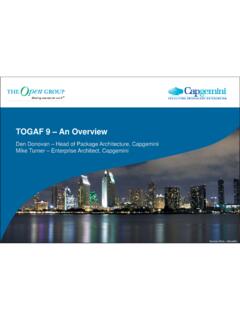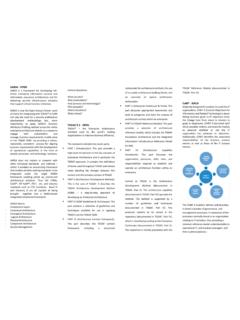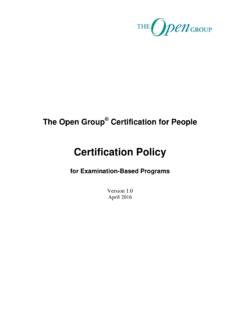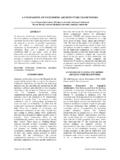Transcription of Enterprise IT Architecture Principles - Ohio Department of ...
1 Office of Information Technology Enterprise IT Architecture Principles Version May 2015 Table of Contents OFFICE OF INFORMATION TECHNOLOGY .. 1 Enterprise IT Architecture .. 1 Principles .. 1 1. PURPOSE OF THIS DOCUMENT .. 4 2. ARCHITECTURAL Principles overview .. 5 ARCHITECTURAL Principles FORMAT .. 5 3. BUSINESS Principles .. 6 BP-001 - STATEWIDE SCOPE OF ARCHITECTURAL Principles .. 6 BP-002 - MAXIMIZE BENEFIT TO THE STATE .. 6 BP-003 - BUSINESS CONTINUITY .. 7 BP-004 - COMMON USE SOLUTIONS .. 8 BP-005 - BUY VS. BUILD .. 8 BP-006 - LIMIT CUSTOMIZATION .. 9 BP-007 - COMPLIANCE WITH LAW .. 9 BP-008 - ENABLE PRODUCTIVITY .. 10 BP-009 - DELIVER INFORMATION AND SERVICES WHEN AND WHERE NEEDED .. 10 BP-010 - MEET BUSINESS REQUIREMENTS .. 11 4. DATA Principles .. 12 DP-001 DATA IS A STATE SHARED ASSET.
2 12 DP-002 DATA INTEGRITY .. 13 DP-003 COMMON VOCABULARY AND DATA DEFINITIONS .. 14 DP-004 DATA SECURITY .. 15 DP-005 DATA INTEGRATION .. 16 DP-006 DATA REPLICATION .. 17 5. APPLICATION Principles .. 19 AP-001 MOBILE FIRST .. 19 AP-002 - EASE-OF-USE .. 20 AP-003 - APPLICATIONS EXPOSE DATA .. 21 AP-004 - SELF-SERVE .. 21 AP-005 STATE APPLICATION COMPONENT REUSE .. 22 6. TECHNOLOGY 23 TP-001 REQUIREMENTS-BASED CHANGE .. 23 TP-002 TECHNOLOGY-BASED CHANGE .. 24 TP-003 CHANGES ARE PLANNED .. 25 TP-004 RESPONSIVE CHANGE MANAGEMENT .. 25 TP-005 USE STATEWIDE TECHNOLOGY INFRASTRUCTURE .. 26 TP-006 INTEROPERABILITY .. 27 TP-007 RESILIENCY AND AVAILABILITY .. 28 TP-008 SCALABILITY AND MODULARITY .. 29 TP-009 INDUSTRY STANDARD TECHNOLOGY .. 29 7. SECURITY Principles .
3 30 SP-001 SECURITY DESIGN .. 30 SP-002 REGULATORY COMPLIANCE .. 30 List of Tables Table 1- Document Revision History .. 4 Table 2 - Architectural Principle Format .. 5 E n t e r p r i s e I T A r c h i t e c t u r e P r i n c i p l e s P a g e 4 1. Purpose of this Document This document details the Enterprise Information Technology (IT) Architecture Principles for the State of Ohio. The purpose of this document is to define the IT Architecture Principles by Business, Data, Application, Technology and Security domains. This document contains a master list of all IT architectural Principles . The IT architectural Principles in this document capture the high-level Enterprise Architecture strategy of the State of Ohio and guide the Information Technology Standards process. Alignment with these Principles will be verified as part of the Strategy and Investment Management review.
4 Principles provide high-level guidance to State initiatives to enhance productivity and ensure effective and efficient use of information technology across the State. The Principles in this document were developed in conjunction with external consultants, and are derived from the Open Group s TOGAF standard, and from other government Architecture Principles . The Enterprise IT Architecture Principles document is owned by the Enterprise IT Architecture & Policy group and is reviewed by the Technology Board prior to submission to the State CIO for final approval. This document will be updated as needed or at least annually. Table 1- Document Revision History Version # Revision Date: Revised by: Description of Changes May 2015 Initial Draft E n t e r p r i s e I T A r c h i t e c t u r e P r i n c i p l e s P a g e 5 2.
5 Architectural Principles overview An IT Architectural Principle is defined as an enduring rule that governs the architectural design attributes and direction of a system or an overall Enterprise . Architectural Principles ensure industry best practices, cost and operational efficiencies, and compliance with the State s Statutes, Provisions, Administrative Rules and Governor s Executive Orders and Directives including the following: Ohio IT-Related Statues: ORC Office of information technology duties of director - contracts ORC 1306 Uniform Electronic Transactions Act ORC Personal information systems definitions State Agency-Specific Provisions: ORC State agency provisions ORC Rules for state agency use of electronic records or signatures ORC Exemptions to public records laws It is mandatory that all relevant architectural Principles be considered when designing architectures.
6 Architectural Principles Format Each principle is enumerated with a rationale and impact statement, and will follow the format below. Table 2 - Architectural Principle Format ID <Principle ID> Name <Principle> Statement The Statement communicates the fundamental architectural rule in sufficient detail to be clearly understood. Rationale The Rationale gives the strategic and business benefits of adhering to the principle. Impact The Impact statement communicates the cost, both for the business and IT, for implementing the principle in terms of resources, costs, and activities / tasks. E n t e r p r i s e I T A r c h i t e c t u r e P r i n c i p l e s P a g e 6 3. Business Principles Following are the architectural Principles within the Business architectural domain. BP-001 - Statewide Scope of Architectural Principles ID BP-001 Name Statewide Scope of Architectural Principles Statement Pursuant to Ohio IT Policy , Authority of the State Chief Information Officer to Establish Policy Regarding the Acquisition and Use of Computer and Telecommunications Products and Services, these architectural Principles are applicable to every organized body, office, or agency established by the laws of the state for the exercise of any function of state government except for those specifically exempted.
7 Rationale The State can only achieve the benefits and efficiencies of an Enterprise Architecture and provide a consistent and measurable level of quality IT services to the citizens of Ohio, when all agencies abide by these architectural Principles . Impact IT initiatives will be reviewed for compliance with the IT architectural Principles as part of the Strategy and Investment Management review. A conflict with a principle will need to be resolved by changing the design of the initiative, or requesting an exception. BP-002 - Maximize Benefit to the State ID BP-002 Name Maximize Benefit to the State Statement Information management decisions are made to provide maximum benefit to the State as a whole. Rationale Decisions made from a statewide perspective have greater long-term value than decisions made from any particular agency perspective.
8 E n t e r p r i s e I T A r c h i t e c t u r e P r i n c i p l e s P a g e 7 Impact Solution components and information will be shared across Agency boundaries. Information management initiatives will be conducted in accordance with the statewide plan. Agencies may have to concede their own preferences for the greater benefit of the entire state. BP-003 - Business Continuity ID BP-003 Name Business Continuity Statement State operations are maintained in spite of system interruptions. Rationale Business operations throughout the State must be provided with the capability to continue their business functions regardless of external events. Implementation of this capability will be dependent upon a risk assessment or business need for each system. Hardware failure, natural disasters, and data corruption must not be allowed to disrupt or stop State activities.
9 Impact This principle is closely related with BP-009 Deliver Information and Services When and Where Needed and TP-007 Resiliency and Availability. Dependency on shared system applications mandates that the risks of business interruption must be established in advance and managed. Management includes, but is not limited to, periodic reviews, testing for vulnerability and exposure, or designing mission-critical services to ensure business function continuity through redundant or alternative capabilities. Recoverability, redundancy, and maintainability should be addressed at the time of design. Applications must be assessed for criticality and impact on the State mission, in order to determine what level of continuity is required and what corresponding recovery plan is necessary. E n t e r p r i s e I T A r c h i t e c t u r e P r i n c i p l e s P a g e 8 BP-004 - Common Use Solutions ID BP-004 Name Common Use Solutions Statement Development of solutions used across the State is preferred over the development of similar or duplicative solutions that are only provided to a particular agency.
10 Rationale Duplicative capability is expensive and proliferates conflicting information. Impact This principle is closely related to: DP-001 Data is a State Shared Asset. Agencies will not be allowed to develop capabilities for their own use that are similar/duplicative of statewide capabilities. In this way, expenditures of scarce resources to develop essentially the same capability in marginally different ways will be reduced. BP-005 - Buy vs. Build ID BP-005 Name Buy vs. Build Statement The State prefers to buy services and solutions where possible. In-house development is reserved for solutions that are not available in the marketplace. Rationale Buy vs. Build allows the State to focus resources on our core mission while still enabling innovation. Common Off-The-Shelf (COTS) and Cloud based solutions are cheaper, quicker, and easier to implement and maintain.

